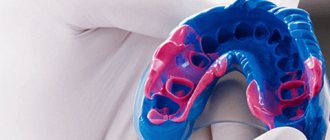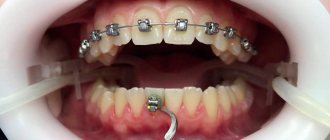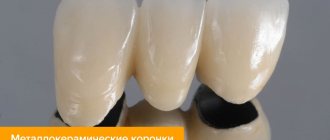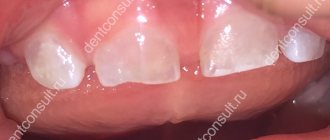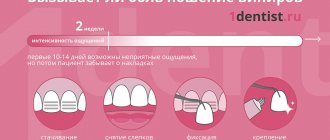Review of modern technologies that allow you to insert teeth
Just 30 years ago, there was only one way to replace lost teeth—prosthetics, and patients were offered crowns made of heavy and unesthetic materials—various metal alloys. And no one was embarrassed by the sight of metal teeth in the smile area. Nowadays, you can insert teeth in such a way that no stranger will even guess that you have a crown or prosthesis in your mouth, and not your natural teeth - to do this, just choose crowns made of metal-ceramics, ceramics or zirconium dioxide.
Teeth can be replaced using dentures or implantation. Both technologies are universal and applicable both for single restorations (in the absence of 1-4 teeth) and for completely toothless jaws.
It is important to understand that implantation does not exclude the stage of prosthetics, however, the crown in this case is not placed on the supporting tooth, but on the abutment of the implant implanted into the jaw bone.
How can you insert teeth in your case? The answer to this question will depend on how many teeth you are missing:
1. If you have teeth, but are severely damaged, you may be offered prosthetic crowns or immediate implantation.
2. If only one tooth is missing in a row, it can be inserted either by installing a denture (bridge) or by implantation. The latter method will be preferable, as it will allow the tooth to be inserted without affecting healthy teeth. The implanted implant will serve as a support for the crown.
3. If a large number of teeth, or even all teeth, are missing in the rows, they can be inserted using removable dentures or dentures on implants.
IMPORTANT: On the Internet you can find many reviews from people who decided to have teeth inserted and subsequently encountered various complications - from pain to prosthesis breakage or implant rejection. There is only one reason for such reviews - poor quality treatment. Therefore, if you decide to have teeth inserted, do not be lazy to spend time carefully choosing the clinic where you will have your teeth inserted.
Both during prosthetics and implantation, you may be offered to insert teeth with different types of dentures and crowns. Let's look at the features, pros and cons of all possible options.
Methods of dental prosthetics in case of large absence of teeth: removable structures
Removable dentures are the main option for recreating a row in the absence of a large number of teeth (more than two in a row). A removable denture consists of several parts:
- The denture base is the basis of the structure, which is located on the gum tissue (can be attached by suction or gluing with medical gel), to which artificial teeth are attached. The base is made from different materials, which determines the cost of the prosthesis, its comfort and other features;
- Artificial teeth made from plastic or porcelain;
- Devices for fixing the prosthesis in the mouth (clasps and micro-locks).
According to their design, depending on the number of teeth being replaced, removable dentures are divided into:
- complete - with complete edentia;
- partial – when part of the dentition is replaced.
When choosing the type of removable denture, pay attention to the material from which it is made. Let's consider the main types of removable structures distinguished by this criterion:
- acrylic;
- nylon;
- clasp
How to make dentures: acrylic denture
Acrylic (plastic) prosthesis is the cheapest prosthetic option. A complete acrylic denture (replacing the entire jaw) is attached by suction, a partial denture is attached to the supporting teeth using a clasp. Using a small acrylic prosthesis (butterfly), you can replace even a single missing chewing tooth (at the patient’s request, if he refuses to grind down the supporting teeth for crowns).
Complete removable acrylic denture.
The advantages of an acrylic prosthesis are:
- Relatively low cost (full or partial dentures in the absence of a large number of teeth - from 10 to 20 thousand, for one or two teeth - 3-4 thousand);
- Lightness of the prosthesis;
- Load distribution when chewing;
- An acrylic prosthesis is made quickly and easily, and is easy for the patient to care for.
Disadvantages of acrylic prosthesis:
- Injury to soft tissues (especially at the beginning of use);
- Possibility of allergic reactions;
- Discomfort when wearing a complete denture due to the overlap of the palate;
- High degree of odor absorption;
- Possibility of damaging abutment teeth with fasteners;
- Impaired diction, possible voluntary collapse of the prosthesis.
Prosthetics in the absence of teeth: nylon prosthesis
The base of a nylon removable denture, unlike an acrylic one, is made of a soft elastic material, which eliminates the design from many of the disadvantages of the latter: rubbing, absorption of odors, etc. Reviews about dental prosthetics in the absence of a large number of teeth using a nylon denture are ambiguous:
- The prosthesis is quite expensive (from 20 thousand rubles) and has a short service life - 2-3 years;
- Eating is uncomfortable due to the heavy load on the gums in places where teeth are missing;
- With prolonged use of a denture, difficulties arise with high-quality cleaning of teeth.
Prosthetic restoration of a missing tooth: clasp design
Byugel represents a design with a metal arc base. The convenience of clasp prosthetics lies in the small volume of the structure and the variety of fastenings (clasps, attachments, telescopic crowns can be used). Bugel has the following advantages:
- correct distribution of chewing load;
- long service life - up to 7 years;
- This design can be installed for bruxism and periodontal disease.
The main and only drawback of the clasp is its high cost - from 50 to 100 thousand rubles.
Complete removable clasp denture.
Insert teeth with metal-ceramic crowns
You can inexpensively replace teeth with metal-ceramic crowns. Such dental prostheses have a metal base and are covered with a layer of ceramic mass on top. This is done so that the finished crown has a natural and aesthetic appearance.
Metal-ceramic crowns are used in both traditional prosthetics and implantation, however, if you need to insert a front tooth, this option of dentures is not suitable. The fact is that the metal from which the base of the crown is made oxidizes over time and this reaction can cause the gums to appear blue in the area where the crown is installed. This cyanosis will be clearly visible when smiling or talking, which of course will affect the level of aesthetics.
If you want to see what a smile will look like if you replace your teeth with metal-ceramic crowns, look at the photos we publish below.
Insert ceramic teeth
Inserting ceramic teeth will be the right decision if you need to restore your front teeth, which are clearly visible when communicating with people around you. But for the restoration of chewing teeth, ceramic crowns are not suitable: ceramics is a fairly fragile material and a crown made from it may not withstand the heavy load that is constantly placed on the chewing teeth when chewing food.
The high aesthetics of ceramic crowns determines the expensive prices for this type of orthopedic structures. But the patient gets a beautiful and natural smile: you can also evaluate the results of dental restoration with ceramic crowns from the photos that we have posted below. Ceramic crowns can be placed on both the abutment tooth and the implant.
Which prosthesis to choose if one or more dental units are missing?
So, if there is no tooth, what kind of prosthesis can be placed? In this case, the patient is offered the following options:
- Immediate prosthesis. This is a crown with artificial gum, which is attached to adjacent teeth using flexible clasps. This type of prosthesis is used mainly temporarily, but some people wear it for a whole year or even longer.
- Dental bridge. A good choice for restoring one unit, provided that the adjacent teeth are pulpless or affected by caries.
- Crown on an implant. The most durable and rational means of prosthetics. When it is used, not only the supragingival but also the subgingival part of the tooth is restored.
Crowns made of pressed ceramics and zirconium dioxide look the most natural and last the longest. When they are installed on implants, it is possible to effectively restore all functions of lost teeth, including aesthetic ones.
How to insert a tooth if there is no root?
If you have had a tooth removed, you can insert it using implantation, and this can be done immediately after the extraction procedure - using the method of one-step implantation. With this method of tooth restoration, implants are implanted directly into the socket of the extracted tooth and then a temporary prosthesis is placed on them. Simultaneous implantation will allow you to insert a tooth and not walk with an unpleasant dentition defect. The doctor will install a permanent crown on the implant abutment after it has fused with the bone - this usually takes 3-4 months.
Implantation is recognized as the most reliable and durable way to restore extracted and lost teeth, but it is not always possible to replace teeth with it - there is a fairly wide range of contraindications for this surgical operation.
What are the features of implantation of chewing teeth?
- When implanting molars, more attention is paid to restoring their functionality and less to aesthetics, since these teeth do not participate in the formation of a smile.
- To recreate molars, large-diameter implants are used that are specially selected for the wide bone in the back of the jaw. Such structures can withstand maximum loads (up to 180 kg).
- Preference is given to one-stage implantation methods, which allow you to restore chewing function in the shortest possible time.
How are dental implants inserted?
Implantation, in order to insert teeth, can be carried out in different ways: according to a one-stage or two-stage protocol. But its essence will always boil down to the following: in order to insert a lost tooth, the doctor will implant a special structure in the patient’s jaw - an implant, on which he will subsequently install a crown or prosthesis.
Until the stage of permanent prosthetics, you will walk with a temporary prosthesis, which is placed during one-stage implantation immediately after implantation. In two-stage implantation, immediate dentures are used to mask dentition defects.
A permanent crown or prosthesis is placed on the implant only after it has completely fused with the natural bone tissue of the jaw. Crowns for installation on an implant can be made from any material: for the restoration of front teeth, ceramic crowns are most often used, for the restoration of chewing units - products made of zirconium and metal-ceramics.
Which implantation technology should I choose to insert teeth? It is impossible to give any absentee recommendations on this matter. You need to visit the clinic, undergo an examination and diagnosis, and only after that the implantologist will offer you the optimal implantation method.
Features of removable dentures
Removable dentures are those that can be removed and installed independently without the help of a specialist. The main indication for their installation is the impossibility of implantation or restoration of dental units with bridges.
The type of construction is chosen based on the number of missing teeth, their location in a row and other factors. There is no best removable denture that would be suitable in all cases; everything is strictly individual.
If you need to insert a tooth after it has been removed
The best solution to insert one tooth is a one-time implantation, but a tooth can only be inserted if too much time has not passed since its removal. To firmly fix the implant in the bone, the jaw bone tissue must be dense and have a certain height. But the longer a tooth is missing, the more the bone thins and dries out. Therefore, if you had a tooth removed several years ago, you can have it replaced either with prosthetics or classical implantation.
How much does it cost to get teeth inserted?
Teeth can be inserted in different ways and using different crowns or dentures, so the price of the service can be very different. Below we publish prices for services for restoring damaged or lost teeth, which are offered by our dental clinic in Moscow - “Aesthetica”!
If you want to insert teeth so that the restoration result is both beautiful and high-quality, come to our dentistry! We have created all the conditions for high-quality, painless dental restoration in the most difficult cases!
If the tooth is not removed, but simply severely damaged
A tooth can decay for various reasons – for example, due to injury. But most often, tooth decay is caused by caries, the treatment of which was not carried out on time. If a tooth is destroyed by more than 50%, the problem cannot be solved by installing a conventional filling. If you put a filling on such a tooth , it may not withstand the load, break or fall out. It’s even worse if the tooth breaks along with the filling and its root part is damaged. This tooth will have to be removed!
Sometimes special auxiliary elements - pins - are used to restore severely damaged teeth. You can put a tooth on a pin and get a fairly reliable and aesthetic restoration result, but again - only if the tooth is not more than fifty percent destroyed! Before placing a filling on a tooth on a pin , the doctor will assess the degree of destruction of the unit. If it is significant, it would be better to put a crown on the tooth! This will protect the tooth from destruction and will allow you to qualitatively restore its aesthetics and all important functional characteristics.
How much does it cost to put a filling on a tooth if it is badly damaged? The cost of installation will depend on the complexity of the treatment, the size of the filling, the material and type of pin that will be used in the process of tooth restoration. On average, put a filling on a tooth in Moscow for an amount ranging from 5 to 8,000 rubles.
If you want to find out the exact cost of the service before putting a filling on a tooth , visit our dental clinic in Moscow - “VENSTOM” and get the most detailed advice on the treatment and restoration of teeth from our specialists!
NOTE: If you have a filling installed, but your tooth hurts and the pain does not subside within several days, be sure to contact your dentist! Such a symptom may indicate poor-quality treatment that did not help stop the inflammatory process!




